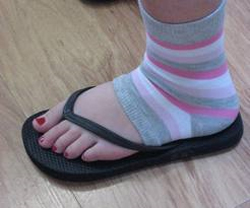Flip Flop Socks

Flip flops are the most popular type of foot wear during the warm summer months, but obviously they are not very suitable for the colder seasons like fall and winter. This may have been true in the past, when flip flops were to be worn on bare feet, but with the introduction of flip flop socks, this too has become thing of the past.
Flip flop socks are not a new invention.
While the west may regard flip flop socks as something new and exciting, there is nothing new about socks designed to be worn in combination with thong type sandals. In fact when our eyes turn to Japan, we will quickly find that flip flop socks are used there for many generations under the name “Tabi socks”.
Tabi socks are made to be worn in combination with the “Tabi” shoe, which is a Japanese variety of the well known thong sandal, or to state it in popular terms: The Japanese flip flops variety.
The socks and shoes date back all the way to the 16th century, where they were used in combination with a wooden type of thong sandal. Today, the Tabi socks and shoes are mostly used by the practitioners of the so called “martial arts”, which resulted in another name for the socks: “ninja socks”.
This trend has only recently caught on in the west, where the ninja socks are worn in combination with the wearer’s favorite type of flip flops, for which they are perfectly suitable.
The real Tabi socks also have health benefits as they are designed to improve posture, and aid by adding support in vital areas of the feet. They are often used in combination with acupuncture therapies.
Alternatives to the flip flop socks
While the Tabi sock is a perfect means to be able to continue to wear thong sandals, there is an alternative type of sock available. They are called “Toe socks” and as the name suggest, they are toe shaped at the end, and therefore suitable to wear in combination with a pair of flip flops. Toe socks are best compared to gloves, because that is what they are; gloves for feet.
While they may be suitable for wearing in combination with flip flops, their drawback is that they are much harder to put on then Tabi socks, which makes them less popular. However, if flip flop socks are not available, they do make a good alternative which is available n most stores were socks are sold.
The recent introduction and popularity of flip flop socks are proof of the fact that west still stands to learn and benefit from the traditions and cultures of eastern origin. This also adds to the functionality of the sandals, which is also yet another cause for the increased popularity of this type of foot wear.
Real Japanese flip flop socks in combinations with flip flops with arch support can work miracles for posture, and bring pain relief in cases of back pain, knee pains and will also minimize the risk of foot injury by relieving the strain on the toes.
Back to Top